American Pit Bull Terrier

 This legendary American breed was developed from various lines of old fighting bulldogs and bullterriers, such as the Irish Bulldog, Staffordshire Bull Terrier, Dudley Terrier, Irish Staffordshire Bullterrier, English Bullterrier, Scottish Blue Paul, English White Terrier and others in the 1800's. A number of breed fanciers maintain that the Pit Bull Terrier contains no terrier blood at all and that it is in fact the original British bulldogge, but these claims are poorly substantiated and oftentimes due to confusion in regards to the history, genetics and the appearance of old bulldogs, as well as their use and working traits.
This legendary American breed was developed from various lines of old fighting bulldogs and bullterriers, such as the Irish Bulldog, Staffordshire Bull Terrier, Dudley Terrier, Irish Staffordshire Bullterrier, English Bullterrier, Scottish Blue Paul, English White Terrier and others in the 1800's. A number of breed fanciers maintain that the Pit Bull Terrier contains no terrier blood at all and that it is in fact the original British bulldogge, but these claims are poorly substantiated and oftentimes due to confusion in regards to the history, genetics and the appearance of old bulldogs, as well as their use and working traits.
Without the terrier influence, there would be no bullterriers and while this should be clear enough for all, further explanation would require the understanding that the bulldogs used in the creation of bullterrier type dogs were mostly working crosses or bandogs themselves, specialized cattledogs whose only requirement for being labeled as "bulldogs" was to be a mastiff-type dog, preferably of supposed Alaunt ancestry and bred to control and (when needed) bait livestock, usually bulls, both for work and entertainment.
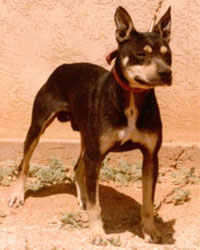
 Just like the old bulldogs were not necessarily a "breed" by modern definitions and they obviously didn't look like the English Bulldog of today, the terriers used in the establishment of the bullterrier category were certainly not lap dogs or show competitors as most of the terrier breeds are presently, but were in fact hard, rugged and intense workers, whose tenacity, agility and stamina, as well as willingness to fight beasts and other dogs any place and any time while disregarding their own safety was their main distinguishing trait from other hunting breeds in old Britain and what was also admired by those who owned fighting bulldogges. So admired were these characteristics that the idea of having a fighter which posessed the physical strength, loyalty and ferocious personality of a bulldog and the agility, intelligence and tenacity of a terrier was enough to revolutionize the way old-time "sport enthusiasts" approached their breeding practices and experiment with different crosses between the two types and attempt to establish a strain of combat-ready dogs superiour to both the bulldog and the terrier, as well as to all others.
Just like the old bulldogs were not necessarily a "breed" by modern definitions and they obviously didn't look like the English Bulldog of today, the terriers used in the establishment of the bullterrier category were certainly not lap dogs or show competitors as most of the terrier breeds are presently, but were in fact hard, rugged and intense workers, whose tenacity, agility and stamina, as well as willingness to fight beasts and other dogs any place and any time while disregarding their own safety was their main distinguishing trait from other hunting breeds in old Britain and what was also admired by those who owned fighting bulldogges. So admired were these characteristics that the idea of having a fighter which posessed the physical strength, loyalty and ferocious personality of a bulldog and the agility, intelligence and tenacity of a terrier was enough to revolutionize the way old-time "sport enthusiasts" approached their breeding practices and experiment with different crosses between the two types and attempt to establish a strain of combat-ready dogs superiour to both the bulldog and the terrier, as well as to all others.
Regional preferences and personal tastes helped shape this new stock of fighting dogs and the percentage of blood from the parental types (as well as the actual strain of each) varied to an extent across the land, but the fact remains that the praised bullterrier category was founded on the basic principle of crossing bulldogges with terriers. Even the old names for the type of dog which would later evolve into the American Pit Bull Terrier reveal the "recipe", with labels such as "Half and Half", "Bulldogge Terrier", "Bull and Terrier", "Staffordshire Fighting Terrier" and so on. Some of these regional differences resulted in the formation of distinct breeds, some of which still exist today, while others were unsuccesful or simply unfortunate ventures of their developers.
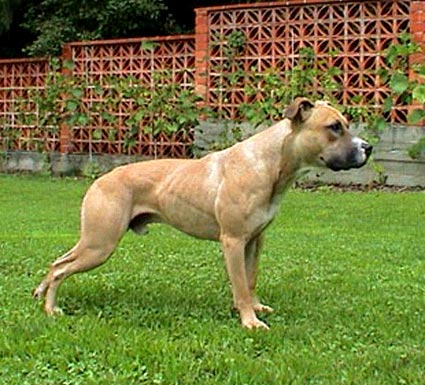
 With the English and Irish bull-n-terrier breeds such as the English Staffordshire Bull Terrier, English Bullterrier and the Irish Staffordshire Bullterrier going through the standardization and refinement process, the dogs introduced to the United States were largely of unknown origin, with some exceptions; many of these dogs simply being companions of immigrant families, while others were brought specifically for the "sport" by Irish, Scottish and English folk from a variety of social backgrounds. Depending on the area in which these immigrants were situated, the dogs that accompanied them soon served as a foundation for a regional variety, with the "Yankee" type being more common in the north and the "Rebel" type forming in the south of America, but even if the southern dogs were heavier and more "bulldoggy" in appearance than their smaller and leaner northern cousins, they all contributed to the establishment of a single breed (albeit retaining a fairly wide phenotypical range) which was the American equivalent of the working bullterriers of Britain, the American Pit Bull Terrier.
With the English and Irish bull-n-terrier breeds such as the English Staffordshire Bull Terrier, English Bullterrier and the Irish Staffordshire Bullterrier going through the standardization and refinement process, the dogs introduced to the United States were largely of unknown origin, with some exceptions; many of these dogs simply being companions of immigrant families, while others were brought specifically for the "sport" by Irish, Scottish and English folk from a variety of social backgrounds. Depending on the area in which these immigrants were situated, the dogs that accompanied them soon served as a foundation for a regional variety, with the "Yankee" type being more common in the north and the "Rebel" type forming in the south of America, but even if the southern dogs were heavier and more "bulldoggy" in appearance than their smaller and leaner northern cousins, they all contributed to the establishment of a single breed (albeit retaining a fairly wide phenotypical range) which was the American equivalent of the working bullterriers of Britain, the American Pit Bull Terrier.

 As unsavory as their common "job" may have been, it is exactly the fighting pit which was instrumental in the remarkable success that the breed as a whole experienced in the United States, because these dogs were tested for the traits which define the Pit Bull Terrier and by following strict requirements in regards to a stable temperament, ease of handling and training, while slowly becoming more uniformed in appearance and breed characteristics which go hand-in-hand with all of the other expectations still placed on the great APBT breed by its true admirers. By breeding for the elusive trait of "gameness" which was inherited from old terriers and improved upon in the APBT population, as well as by culling cowards and man-biters from the gene pool, the breed developers were able to create a dog which truly differs from all other breeds and is deservedly one of the most cherished legacies of old America.
As unsavory as their common "job" may have been, it is exactly the fighting pit which was instrumental in the remarkable success that the breed as a whole experienced in the United States, because these dogs were tested for the traits which define the Pit Bull Terrier and by following strict requirements in regards to a stable temperament, ease of handling and training, while slowly becoming more uniformed in appearance and breed characteristics which go hand-in-hand with all of the other expectations still placed on the great APBT breed by its true admirers. By breeding for the elusive trait of "gameness" which was inherited from old terriers and improved upon in the APBT population, as well as by culling cowards and man-biters from the gene pool, the breed developers were able to create a dog which truly differs from all other breeds and is deservedly one of the most cherished legacies of old America.

 The A.P.B.T. is still seen by many as the same thing as the American Staffordshire Terrier breed, while others are convinced that crucial temperament and appearance differences are a solid basis for separate recognition. Just like the early APBT evolved from the non-Show population of the original English Bullterrier breed, the AmStaff was established by selecting dogs from the APBT's non-performance stock. While the working pit dogs have never been bred for size or appearance, their non-fighting counterparts in the common American bull-n-terrier population were becoming more refined and popular Show dogs, resulting in the practice of breeding a type which is very different from that employed for the original purpose-bred "sport" animals, disregarding "gameness" and fighting ability, thus establishing a slightly larger, slower and softer subgroup in the breed, which eventually became a well-loved breed on its own, the American Staffordshire Terrier. It should be noted that many Pit Bulls are registered as AmStaffs and are allowed to compete in Conformation Shows under that name.
The A.P.B.T. is still seen by many as the same thing as the American Staffordshire Terrier breed, while others are convinced that crucial temperament and appearance differences are a solid basis for separate recognition. Just like the early APBT evolved from the non-Show population of the original English Bullterrier breed, the AmStaff was established by selecting dogs from the APBT's non-performance stock. While the working pit dogs have never been bred for size or appearance, their non-fighting counterparts in the common American bull-n-terrier population were becoming more refined and popular Show dogs, resulting in the practice of breeding a type which is very different from that employed for the original purpose-bred "sport" animals, disregarding "gameness" and fighting ability, thus establishing a slightly larger, slower and softer subgroup in the breed, which eventually became a well-loved breed on its own, the American Staffordshire Terrier. It should be noted that many Pit Bulls are registered as AmStaffs and are allowed to compete in Conformation Shows under that name.

 The name "Pit Bull" is unfortunately sometimes used for any breed or mongrel that resembles these great dogs, creating additional confusion. In the early years, the American Pit Bulldogge and the American Pit Bull Terrier were seen as cousins and not the same breed, but although some fanciers still respect old rules, the majority of modern owners and members of the general public do not differentiate between them at all. Rural working dogs have generally always been larger than their fighting counterparts in the big cities, essentially forming two distinct breed variants. While old farm bulldogges of the United States eventually became a separate breed presently recognized as the American Bulldog, the original "in-between" variety known as the American Pit Bulldog has survived as a sub-type of the greater APBT breed. Being primarily working dogs, there hasn't really been a strong emphasis on physical appearance, strict measurements and proper type requirements of the Pit Bull population until fairly recently, at least not before the dogs started being exhibited in Shows.
The name "Pit Bull" is unfortunately sometimes used for any breed or mongrel that resembles these great dogs, creating additional confusion. In the early years, the American Pit Bulldogge and the American Pit Bull Terrier were seen as cousins and not the same breed, but although some fanciers still respect old rules, the majority of modern owners and members of the general public do not differentiate between them at all. Rural working dogs have generally always been larger than their fighting counterparts in the big cities, essentially forming two distinct breed variants. While old farm bulldogges of the United States eventually became a separate breed presently recognized as the American Bulldog, the original "in-between" variety known as the American Pit Bulldog has survived as a sub-type of the greater APBT breed. Being primarily working dogs, there hasn't really been a strong emphasis on physical appearance, strict measurements and proper type requirements of the Pit Bull population until fairly recently, at least not before the dogs started being exhibited in Shows.

 A breed of immense physical power and rarely matched tenacity and prey drive, the American Pit Bull Terrier is first and foremost a fighting dog. Any other claim is simply ridiculous. Due to its popularity and overbreeding, many strains posess unstable temperaments and overly vicious tendencies. This is unfortunate, because it resulted in worldwide bans and social condemnation of the breed. A well bred, pure American Pit Bull Terrier is harmless to humans and a loving family dog, while retaining its gameness and courageous character. This is not to say that only a fighting Pit Bull is a good one, because the "sport" of dog-fighting is rightfully illegal and frowned upon. But, a Pit Bull Terrier should always be a dog that is ready and able to fight, that's what makes it a Pit Bull Terrier.
A breed of immense physical power and rarely matched tenacity and prey drive, the American Pit Bull Terrier is first and foremost a fighting dog. Any other claim is simply ridiculous. Due to its popularity and overbreeding, many strains posess unstable temperaments and overly vicious tendencies. This is unfortunate, because it resulted in worldwide bans and social condemnation of the breed. A well bred, pure American Pit Bull Terrier is harmless to humans and a loving family dog, while retaining its gameness and courageous character. This is not to say that only a fighting Pit Bull is a good one, because the "sport" of dog-fighting is rightfully illegal and frowned upon. But, a Pit Bull Terrier should always be a dog that is ready and able to fight, that's what makes it a Pit Bull Terrier.

 As much as the backyard breeders and the criminal element are responsible for the demise of this breed, so are the modern commercial breeders that are trying to turn the Pit Bull into something it is not, by breeding out its dog-aggressive nature. This results in a a dog without its personality, but with a strong prey drive, which is often aimed at humans, unlike the game-bred dogs which pose no threat to people. It is both the reckless overbreeding and these attempts to breed the APBT away from its true self, that regretably result in well known media reports about attacks on humans, oftentimes children. Even though it seems that there is no room for Pit Bulls in today's society, this is still one of the most popular breeds in America, as well as worldwide. A little known fact is that the primary reason for the very formation of the United Kennel Club (UKC) by Chauncey Bennett in 1898 was the official registration of the American Pit Bull Terrier breed. An even lesser known fact is that the early UKC was also in charge of overseeing testing contests, specifically keeping records and regulating pit fighting events, as well as providing official referees for those matches, before eventually succumbing to the societal pressure in the 1940's and fully distancing itself from the "sport" which helped build it. While UKC quickly evolved into a "regular" registry, the famed American Dog Breeders Association (ADBA) which was founded in 1909 by Guy McCord to this day remains the only registry taken seriously by the majority of APBT enthusiasts, because it not only examines the dogs' purity and physical conformation, but also tests their agility, stamina and strength, primarily through weight-pulling excercises.
As much as the backyard breeders and the criminal element are responsible for the demise of this breed, so are the modern commercial breeders that are trying to turn the Pit Bull into something it is not, by breeding out its dog-aggressive nature. This results in a a dog without its personality, but with a strong prey drive, which is often aimed at humans, unlike the game-bred dogs which pose no threat to people. It is both the reckless overbreeding and these attempts to breed the APBT away from its true self, that regretably result in well known media reports about attacks on humans, oftentimes children. Even though it seems that there is no room for Pit Bulls in today's society, this is still one of the most popular breeds in America, as well as worldwide. A little known fact is that the primary reason for the very formation of the United Kennel Club (UKC) by Chauncey Bennett in 1898 was the official registration of the American Pit Bull Terrier breed. An even lesser known fact is that the early UKC was also in charge of overseeing testing contests, specifically keeping records and regulating pit fighting events, as well as providing official referees for those matches, before eventually succumbing to the societal pressure in the 1940's and fully distancing itself from the "sport" which helped build it. While UKC quickly evolved into a "regular" registry, the famed American Dog Breeders Association (ADBA) which was founded in 1909 by Guy McCord to this day remains the only registry taken seriously by the majority of APBT enthusiasts, because it not only examines the dogs' purity and physical conformation, but also tests their agility, stamina and strength, primarily through weight-pulling excercises.
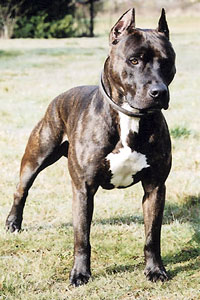
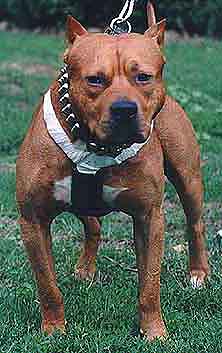 Just like in the past, hunting is a popular venue for fanciers of the breed who value the working qualities of the Pit Bull to enjoy a legal and traditional activity which tests the abilities of their dogs. Another popular sport is Weight-Pulling, but a fair number of breed representatives used for this activity are quite large, some of them suspected to come from mixed lines, just like those used for Protection trials, many of which are working bandogge crosses. While a pure APBT can make a good watchdog, it should never be used as an attack dog or expected to actually engage in combat with people, but some neophyte "fanciers" disregard the breed's true heritage and old rules, turning their dogs into vicious "man-stoppers", most of which contain foreign blood anyway. But once one of these man-made monsters attacks or even kills someone, the general public and especially the media disregard the fact that the dogs in question are not even true American Pit Bull Terriers and instead choose to further demonize the entire breed based on actions of these mongrels.
Just like in the past, hunting is a popular venue for fanciers of the breed who value the working qualities of the Pit Bull to enjoy a legal and traditional activity which tests the abilities of their dogs. Another popular sport is Weight-Pulling, but a fair number of breed representatives used for this activity are quite large, some of them suspected to come from mixed lines, just like those used for Protection trials, many of which are working bandogge crosses. While a pure APBT can make a good watchdog, it should never be used as an attack dog or expected to actually engage in combat with people, but some neophyte "fanciers" disregard the breed's true heritage and old rules, turning their dogs into vicious "man-stoppers", most of which contain foreign blood anyway. But once one of these man-made monsters attacks or even kills someone, the general public and especially the media disregard the fact that the dogs in question are not even true American Pit Bull Terriers and instead choose to further demonize the entire breed based on actions of these mongrels.
Regardless of breed type and the duty it is expected to perform, a pure APBT should be an energetic, playful and devoted family dog, posessing an even temperament and great intelligence, turning to conflict with intruders on its property only as a last resort. Many lovers of the breed often say that burglars could freely steal everything in the house guarded by a pure APBT and even take the dog with them because of the great love of humans these dogs are known for. Those that want a perfect protection dog should look elsewhere and not expect a breed that built its early reputation on the fact it is harmless to people to be something it isn't.
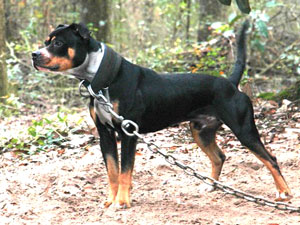 This beautiful and impressive American breed needs responsible and firm handling, as well as early socializing around people and animals, especially strange dogs. There is a variety of sizes and appearance preferences, from small lightweight fighting bull-n-terrier dogs to those naturally larger bulldogge-type Pit Bulls that are taller and bulkier, oftentimes used for Weight-Pull duties and hunting. There are even some giant Pit Bull strains, resembling old working bulldogges more than they do the original bullterriers, but it should be noted that even though traditionally a difference has been made between true Pit Bulls and true Pit Bull Terriers, based on size and the percentage of terrier blood, many oversized mastiff-type Pits seen today come from "enriched" bloodlines, usually resulting from introducing Dogue de Bordeaux, American Bulldog, Olde English Bulldogge, Bullmastiff, Presa Canario, Cane Corso and common bandogge types to the gene pool.
This beautiful and impressive American breed needs responsible and firm handling, as well as early socializing around people and animals, especially strange dogs. There is a variety of sizes and appearance preferences, from small lightweight fighting bull-n-terrier dogs to those naturally larger bulldogge-type Pit Bulls that are taller and bulkier, oftentimes used for Weight-Pull duties and hunting. There are even some giant Pit Bull strains, resembling old working bulldogges more than they do the original bullterriers, but it should be noted that even though traditionally a difference has been made between true Pit Bulls and true Pit Bull Terriers, based on size and the percentage of terrier blood, many oversized mastiff-type Pits seen today come from "enriched" bloodlines, usually resulting from introducing Dogue de Bordeaux, American Bulldog, Olde English Bulldogge, Bullmastiff, Presa Canario, Cane Corso and common bandogge types to the gene pool.
It should be noted that a small numbers of breeders of the "alternative" strains are supporting the idea and have proclaimed a new breed to enforce the separation under the American Bully name, this idea being fully endorsed by the true fans of the traditional purebred APBT. Regardless of type, all varieties of the breed should be muscular, strong and agile, with well-boned bodies, strong necks and broad heads. Red-nosed specimens are highly regarded by some breed fanciers, but the majority of Pit Bull Terriers are darkly pigmented, although albino dogs exist as well. The ears may be cropped or left natural, in which case any ear-type is allowed. Some fighting and hunting dogs with docked tails existed in the past, but the majority of modern examples are unaltered.
The short, hard coat comes in all colours, solid or particoloured, without any preference for a specific colouring, but many modern commercial breeders base their programmes on a single colour, especially if it is "rare" or trendy. Average height for the Pit Terrier type is around 18 inches, with game-bred dogs usually being smaller and lighter, but the "Bully" variety can get much taller and heavier.
